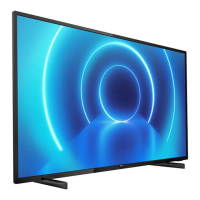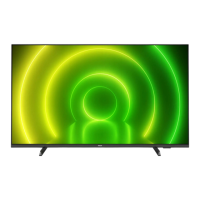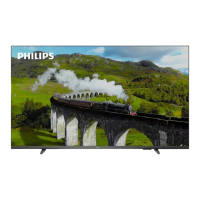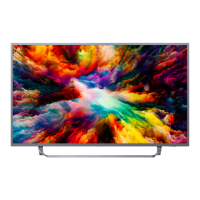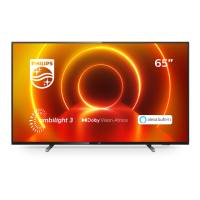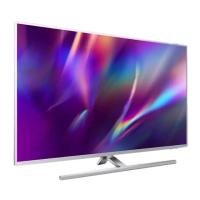
Do you have a question about the Philips 43PUS7505 and is the answer not in the manual?
| Screen shape | Flat |
|---|---|
| Response time | - ms |
| Display diagonal | 43 \ |
| Display brightness | - cd/m² |
| Display technology | LED |
| Native aspect ratio | 16:9 |
| Contrast ratio (typical) | - |
| Screen format adjustments | Zoom |
| Motion interpolation technology | PPI (Picture Performance Index) 1500 |
| Tuner type | Analog & digital |
| Analog signal format system | PAL, SECAM |
| Digital signal format system | DVB-C, DVB-S, DVB-S2, DVB-T, DVB-T2, DVB-T2 HD |
| Video apps | Netflix, YouTube |
| Audio decoders | Dolby Atmos |
| RMS rated power | 20 W |
| Number of speakers | 2 |
| Equalizer bands quantity | 5 |
| Wi-Fi standards | Wi-Fi 4 (802.11n) |
| Product color | Black |
| Mercury content | 0 mg |
| Rollable display | No |
| Heavy metals free | Hg (mercury) |
| Panel mounting interface | 200 x 200 mm |
| Processor cores | 4 |
| Teletext standards | Hyper-text |
| Audio formats supported | AAC, MP3, WAV, WMA, WMA-PRO |
| Image formats supported | BMP, GIF, HEIF, JPEG, PNG |
| Video formats supported | AVC, AVI, H.264, HEVC, MKV, MPEG1, MPEG2, MPEG4, VC-1, VP9, WMV9 |
| Video compression formats | HEVC |
| Subtitle formats supported | ASS, SMI, SRT, SSA, SUB, TXT |
| High Dynamic Range (HDR) technology | Dolby Vision, High Dynamic Range 10 (HDR10), High Dynamic Range 10+ (HDR10 Plus), Hybrid Log-Gamma (HLG) |
| HDMI ports quantity | 3 |
| USB 2.0 ports quantity | USB 2.0 ports have a data transmission speed of 480 Mbps, and are backwards compatible with USB 1.1 ports. You can connect all kinds of peripheral devices to them. |
| Ethernet LAN (RJ-45) ports | 1 |
| Consumer Electronics Control (CEC) | EasyLink |
| USB 3.2 Gen 1 (3.1 Gen 1) Type-A ports quantity | 0 |
| Programming period | 8 day(s) |
| Firmware upgradeable via | Auto upgrade wizard, Network, USB |
| AC input voltage | 220 - 240 V |
| AC input frequency | 50 - 60 Hz |
| Energy efficiency scale | A to G |
| Power consumption (standby) | 0.3 W |
| Power consumption (typical) | 71 W |
| Operating temperature (T-T) | 5 - 35 °C |
| Cables included | AC |
| Package type | Box |
| Package weight | Weight of the packaged product in gram. |
| Refurbished grade | Grade C |
| Width (with stand) | - mm |
|---|---|
| Weight (with stand) | - g |
| Depth (without stand) | 84.3 mm |
| Width (without stand) | 972.7 mm |
| Height (without stand) | 567.9 mm |
| Weight (without stand) | 7800 g |
Find and register your TV's model and serial number for support.
Access the TV's built-in help and user manual for diagnostics.
Contacting consumer care for support and repair services.
Update TV software via internet or USB for optimal performance.
View current software version and update history.
Enable or disable automatic TV software updates.
Instructions for remote control battery replacement, cleaning, and key overview.
Details on the IR sensor and using the joystick for basic TV operations.
Read safety instructions and tips for optimal TV placement.
Connecting the power cable and initial steps to turn on the TV.
Connecting Antenna, Satellite, Video (HDMI), and Audio devices.
Using HDMI ARC for audio return and Optical Audio Out for sound.
Screen Mirroring, Remote App, CAM, Smart Card, and USB connections.
Accessing the source list and renaming connected devices for clarity.
Watching channels, using lists, and installing channels via antenna/cable.
Installing satellite channels, LNB settings, and managing satellite configurations.
Setting channel options, managing channel lists, and favourites.
Accessing and configuring Teletext services.
Navigating and using the TV Guide to view programme schedules and details.
Viewing media files from USB connections or computer/NAS.
Viewing photos, creating slideshows, and managing photo options.
Playing video and music files from USB or network with playback controls.
Overview of Home menu structure and accessing frequent/all settings.
Adjusting picture styles, colour, sound styles, and audio configurations.
Digital audio, HbbTV, HDMI, Eco modes, and network configurations.
Universal access, lock settings, language preferences, and clock.
Connecting the TV wirelessly or via wired Ethernet to your home network.
Viewing network configuration, static IP, and managing Wi-Fi connections.
Netflix settings, clearing internet memory, and DMR functionality.
Initial setup and accessing apps and internet from the Smart TV start page.
Browsing apps, downloading from the gallery, and renting movies.
Understanding energy efficiency class and product specifications.
Proper disposal instructions for old products and batteries.
Details on power, reception standards, and display resolution.
List of supported video input resolutions and timing formats via HDMI.
List of supported input resolutions for computer connections.
Specifications for audio, multimedia codecs, and available connections.
Finding solutions and troubleshooting TV not switching on or remote control issues.
Troubleshooting missing channels, satellite reception, and installation problems.
Resolving problems with no picture, distorted picture, or no sound.
Important safety instructions to prevent electric shock, fire, injury, and damage.
Preventing TV falls and safety guidelines for battery handling.
Preventing overheating, lightning damage, and cleaning the TV screen safely.
Trademarks and licensing information for HDMI, Dolby, DTS, and Wi-Fi.
Details about open source software used and how to obtain source code and licenses.

